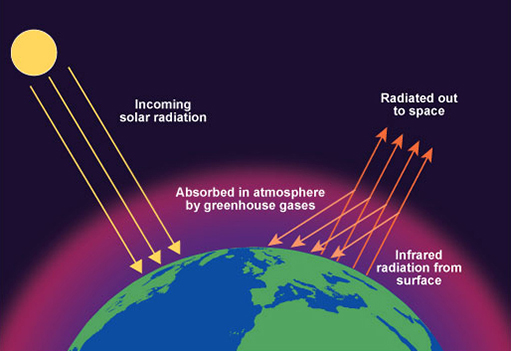Climate on the other hand is the statistical average of these weather conditions at a particular place over a long period of time, typically 30 years. This includes temperature, wind and rainfall patterns. In contrast to the instantaneous conditions described by weather, climate is described with average values (e.g. annual average temperature), but also typical variability (e.g. seasonal maximum/minimum temperatures) and frequency of extreme events. The timescale upon which climate statistics are calculated is typically thirty years.
Earth's Climate System
The state of the Earth’s climate is determined by the amount of energy stored by the climate system, and especially the balance between energy received from the Sun and the portion of this energy which the Earth releases back to space. This global energy balance is regulated in large part by the flows of energy within the global climate system.
“The climate system is the highly complex system consisting of five major components: the atmosphere, the hydrosphere, the cryosphere, the lithosphere and the biosphere, and the interactions between them. The climate system evolves in time under the influence of its own internal dynamics and because of external forcings such as volcanic eruptions, solar variations and anthropogenic forcings such as the changing composition of the atmosphere and land use change.” - IPCC AR5 report
As the Earth is a sphere an enormous amount of the sun's energy (solar radiation) hits the Earth between the tropics of Capricorn and Cancer. At the poles less solar radiation is received and the ice sheets also reflect incoming sunlight cooling the poles even more. The climate system balances this surplus and deficit by transporting energy and heat through air and vapour in the atmosphere and through the water in the oceans.
Generally speaking, the climate remains steady over long periods of time if the various elements within the system remain stable. However, if one or more of the components of the system is altered, the stability of the whole system is compromised and can lead to uncharacteristic behaviour and give rise to weather which is outside the expected range. This situation can be described as climate change.
When the Earth's energy budget changes, the climate follows. A change in the energy budget is called a forcing, and when the change is caused by something outside of the five components of the climate system, it is called an external forcing.
There are four main known influences of larger long-term changes in the Earth’s climate.
- Changes in the Earth’s orbit around the Sun
- Variations in the output of energy from the Sun
- Changes in ocean circulation
- Changes in the composition of the atmosphere.
Though the first three influences are beyond the control of humankind, the composition of the atmosphere has been altered by human activities (anthropogenic climate drivers) for over 200 years that include emissions of greenhouse gases and changes in land use.
The Greenhouse Effect
The earth's surface is warmed by the sun during the day and at night the earth realises some of this absorbed heat back into space in the form of infrared radiation.

The greenhouse effect is a process that occurs when naturally occurring gases (Greenhouse Gases) in the earth's atmosphere traps some of this infrared radiation and acts as a partial blanket the helps keep the planet warmer than it otherwise would be. They do this by selectively absorbing and emitting radiation – they are relatively transparent to shortwave radiation from the Sun while they absorb long wavelength radiation for the Earth.
In the absence of the Greenhouse effect, the earth would be a much colder place than it is today - the average temperature of Earth's surface would be about −18 °C rather than the present average of 15 °C
[Ref: 1998, Qiancheng Ma, Greenhouse Gases: Refining the Role of Carbon Dioxide, Nasa Science Briefs].
Our modern lifestyles have resulted in the release of large amounts of greenhouse gases into the atmosphere, enhancing the greenhouse effect and pushing up temperatures globally.
Climate Feedback
When one climatic process triggers changes to a second process, which in turn influences the first process, this interaction is called ‘climate feedback’.
A positive feedback intensifies the original process, whereas a negative feedback reduces it.
Understanding climate feedbacks is not only important to explaining the climate change that we are currently observing, but is also important when considering what could happen in the future.
For example, as global warming occurs, the amount of water vapour in the atmosphere increases because warmer air can hold more moisture. Water vapour is also a very effective greenhouse gas, so it contributes to further warming. Likewise, snow and ice reflect a large amount of incoming solar radiation back into space (high albedo). As snow and ice disappear in response to a warming climate the darker surfaces underneath absorb more solar radiation, which contributing to surface warming and in turn speeds up the disappearance of snow and ice even further. This process is being observed in places like the Arctic today, where reduced ice and snow cover contribute to increased warming in these sensitive climates